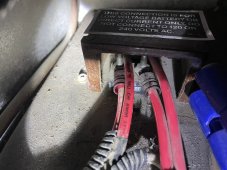I'm upgrading the system in my RV and want to move the battery location while I'm at it. 8awg is already run under the floors, and I don't want to tear everything apart, so I'm planning to extend the existing wires to their new location. I'll be following Will's schematic for "400 Watt Solar Package w/Alternator Charging", and using his recommended breaker and wiring recommendations: https://www.mobile-solarpower.com/simplified-400-watt-fewer-wires-and-alternator-charging.html
The original system has two 8awg wires I need to extend: one goes to my DC fusebox (small loads, way under 30A), and one carries current from my alternator (10A max, limited by Kisae DMT1250). In the original system they each pass through a 30a breaker before connecting to the battery. I could add the 4awg wires before or after the 30a breaker, and I'm not sure which way is best.
Original roundtrip with the existing 8awg is about 12', and 3' will be removed when I add 6' of 4awg. So when completed it'll be about 9' of 8awg and 6' of 4awg. 100AH lithium battery w/100A BMS...and I may add another identical battery later to facilitate a 2000W inverter. (Currently I'm relying on the inverter from my Bluetti AC200MAX).
So: do I need to keep the 30a breakers to protect the 8awg downstream, or will the larger breakers closer to the battery suffice?
Thanks!
The original system has two 8awg wires I need to extend: one goes to my DC fusebox (small loads, way under 30A), and one carries current from my alternator (10A max, limited by Kisae DMT1250). In the original system they each pass through a 30a breaker before connecting to the battery. I could add the 4awg wires before or after the 30a breaker, and I'm not sure which way is best.
Original roundtrip with the existing 8awg is about 12', and 3' will be removed when I add 6' of 4awg. So when completed it'll be about 9' of 8awg and 6' of 4awg. 100AH lithium battery w/100A BMS...and I may add another identical battery later to facilitate a 2000W inverter. (Currently I'm relying on the inverter from my Bluetti AC200MAX).
So: do I need to keep the 30a breakers to protect the 8awg downstream, or will the larger breakers closer to the battery suffice?
Thanks!




